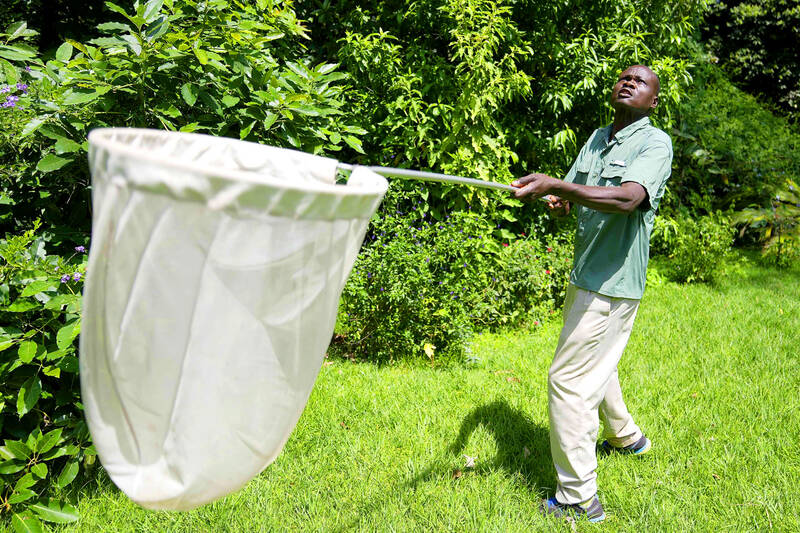What began as a childhood hobby more than six decades ago has led to what might be Africa’s largest butterfly collection in a suburb of Kenya’s capital, Nairobi.
Steve Collins, 74, was born and raised in western Kenya. By the age of 5, he was fascinated by butterflies and started building a collection that has grown to more than 4.2 million, representing hundreds of species.
“My parents encouraged us to look for butterflies after visiting the Congo and were gifted a trapping net by some friends,” Collins said. “By the time I was 15 years old, I was already visiting other countries like Nigeria to study more about butterflies.”

Photo: AP
During his 20-year career as an agronomist, Collins dedicated his free time to research. He established the African Butterfly Research Institute in 1997.
Now, running out of space and time, he hopes to hand it over to the next generation.
On his 0.6 hectares of land, hundreds of indigenous trees and flowering bushes form a well-knit forest. Hundreds of butterflies dance from one flower to another, at times landing on Collins’ hand.

Photo: AP
His collection is private, although it was initially open to the public when he ran it as an education center between 1998 and 2003.
Collins has 1.2 million butterflies from across Africa delicately pinned in frames and stored in rows of shelves, with another 3 million in envelopes.
“They need to be kept in dark spaces,” he said. “The form of storage also ensures the dried butterflies are not eaten by other insects, parasites and predators. We also ensure we apply insecticides once a year to keep them safe.”
Julian Bayliss, an ecologist specializing in Africa and a visiting professor at Oxford Brookes University, said he has collected butterflies for Collins over two decades.
“There is a large part of that collection that is completely irreplaceable because a large part of Africa’s habitat is being destroyed,” Bayliss said.
Africa is particularly vulnerable to climate change, with periods of prolonged drought and serious flooding destroying forests and other butterfly habitats.
Bayliss suggested digitizing the collection to make it accessible worldwide.
Whoever takes it over “needs to be an institution that is well-founded, well-funded and secure,” he said.
Scott Miller, an entomologist at the Smithsonian Institution, met Collins almost 30 years ago. He said such collections provide critical information that could show environmental changes over 60 years.
“These physical specimens, you can actually keep going back to them to get new layers of information as you learn more, or you get a different technology or you get different questions,” Miller said.
Collins is concerned that soon he would no longer be able to sustain his research. He said his most prized butterfly costs US$8,000 — which he keeps from sight, concerned about possible theft — and hopes to sell the collection to an individual or research institution.
The costs of running his institute are high. An annual budget posted in 2009 on the Lepidopterists’ Society of Africa Web site was US$200,000.
Collins estimates that the specimens and other assets are worth US$8 million.
“This has been my hobby for decades, and I can’t put a price on what I have done so far. I’m currently seeking to ensure the species are in safe hands when I’m out of this world,” Collins said.

BRUSHED OFF: An ambassador to Australia previously said that Beijing does not see a reason to apologize for its naval exercises and military maneuvers in international areas China set off alarm bells in New Zealand when it dispatched powerful warships on unprecedented missions in the South Pacific without explanation, military documents showed. Beijing has spent years expanding its reach in the southern Pacific Ocean, courting island nations with new hospitals, freshly paved roads and generous offers of climate aid. However, these diplomatic efforts have increasingly been accompanied by more overt displays of military power. Three Chinese warships sailed the Tasman Sea between Australia and New Zealand in February, the first time such a task group had been sighted in those waters. “We have never seen vessels with this capability

A Japanese city would urge all smartphone users to limit screen time to two hours a day outside work or school under a proposed ordinance that includes no penalties. The limit — which would be recommended for all residents in Toyoake City — would not be binding and there would be no penalties incurred for higher usage, the draft ordinance showed. The proposal aims “to prevent excessive use of devices causing physical and mental health issues... including sleep problems,” Mayor Masafumi Koki said yesterday. The draft urges elementary-school students to avoid smartphones after 9pm, and junior-high students and older are advised not

Philippine President Ferdinand Marcos Jr has fired his national police chief, who gained attention for leading the separate arrests of former Philippine president Rodrigo Duterte on orders of the International Criminal Court and televangelist Apollo Carreon Quiboloy, who is on the FBI’s most-wanted list for alleged child sex trafficking. Philippine Executive Secretary Lucas Bersamin did not cite a reason for the removal of General Nicolas Torre as head of the 232,000-member national police force, a position he was appointed to by Marcos in May and which he would have held until 2027. He was replaced by another senior police general, Jose

POWER CONFLICT: The US president threatened to deploy National Guards in Baltimore. US media reports said he is also planning to station troops in Chicago US President Donald Trump on Sunday threatened to deploy National Guard troops to yet another Democratic stronghold, the Maryland city of Baltimore, as he seeks to expand his crackdown on crime and immigration. The Republican’s latest online rant about an “out of control, crime-ridden” city comes as Democratic state leaders — including Maryland Governor Wes Moore — line up to berate Trump on a high-profile political stage. Trump this month deployed the National Guard to the streets of Washington, in a widely criticized show of force the president said amounts to a federal takeover of US capital policing. The Guard began carrying